Namaste,
The Taj Mahal, an ivory-white marble mausoleum on the South bank of Yamura River in Agra, is the most admired and photographed edifice in India. The building was and remains the most perfect ever built by man. It was commissioned in 1632 by Emperor Shah Jahan to express the love for his wife Empress Mumtaz Mahal, who died giving birth to their fourteenth child or ninth for some others, when we love we cannot count, right?… In 1983, the Taj Mahal was designed as a UNESCO World Heritage site.
Once past the regulatory searched by the security service from the massive door arch appears the Taj in its most famous vision with its spectacular marble dome which seems close and irresistibly attracts the visitor. The dome is 115 feet high and sits on a cylindrical drum of about 23 feet high. The top is decorated with a lotus design and a gold finial, which was replaced by a copy made of gilded bronze in the 19th century. The finial is topped by the moon, a typical Islamic motif. From the main entrance of the tomb, we first discover the formal garden and a reflecting pool at the center. The reflecting pool is lined with an avenue of cypress trees symbolizing death, and fountains all the way to the mausoleum reflecting the grandeur of the tomb, framed by four minarets. The Taj complex is bordered on three sides by red sandstone walls and the side facing the river is open. At the far end of the complex on both sides of the mausoleum, two major red sandstone buildings that mirror each other (including a mosque) which enhance the symmetry of the whole complex. Symmetry is a fundamental element of the Taj: the garden, the reflecting pool, and the two secondary buildings allow the Taj Mahal to appear in perfect balance as the culmination of harmony. As at Agra Red Fort, the luminous mass of white marble is balanced by the use of decorations, floral arabesques and geometric patterns executed in polychrome precious and semi-precious gemstones: turquoise, coral, malachite, lapis lazuli, and inlay into the white marble using the technique of pietra dura. The decorations are the finest in Mughal architecture. Imagine, up to thirty-five types of gemstones were used and a single flower could contain more than sixty pieces.

Taj Mahal – Red sandstone buildings
To make the discovery of the Taj Mahal even more magical, I dressed in a traditional Indian orange Sari (for those who know me extremely well, they can say, it is bordering record of the year!) Sari consists of a drape always measuring about 18 feet long and about 4 feet wide. No way to talk about S or XXL size, the sari is wrapped around your waist, and the end over your shoulder, but the most important is to follow the body curves to “lavishly and gracefully” enhance the silhouette… Q.E.D. So here, I was dressed like “Bollywood Fashion” for the day (a huge thank you to the girl at the hotel who dressed me in 10 minutes, stopwatch in hand… because after all it is just an 18-foot long piece of cloth.) The encounter with the Taj was magical… What I did not anticipate was the curiosity of people and an incalculable number of photos I had to undergo with a smile… a true star of the day on Bollywood Boulevard !
The next step of this journey is Fatehpur Sikri in the Agra district. A splendid imperial city whose the red sandstone buildings are in perfect condition. The story of the origin of this mysterious city is subject of a legend. At Sikri lived a Sufi saint, Sheikh Salim Chishti, Emperor Akbar, who did not have any heir went to consult; a son was born the following year and Akbar, grateful, built a palace in this location. During the next fifteen years, thousands of craftsmen built the city of Sikri, including palaces, mosque, harem and other buildings. Akbar renamed the new city Fatehpur, Fateh meaning “Victorious”. But he abandoned the imperial complex in 1585, 14 years after its completion, due to lack of water, and also due to the proximity to the Rajputana areas in the North-West in perpetual turmoil at the time. Fatehpur becomes a ghost town. Beyond the front door, in a vast yard, we discover the Diwan-i-Am (Hall of public audience) with its arches and columns inlaid sandstone. Inside the city, palaces, pavilions, and mosques reflect the power of the empire by amalgamating the best of Mughal and Rajput architectural traditions. In the vast courtyard, the tomb of Sheikh Salim Chishti is a small white marble mausoleum. Built in 1580, the tomb is complemented in 1606 by carved jalis; marble pierced screens. This striking artwork is a wonderful example of the Hindu craftsmanship of that era; when we stand on the outside, we cannot see the inside, contrary when inside the room, we can see perfectly outside: astonishing ?

Fatehpur Siri – Tomb of Sheikh Salim Chishti
It is time to explore Rajasthan, “Land of Kings,” a Northern Indian state bordering Pakistan. Rajasthan is the largest Indian state with 132,139 square miles, representing about 10.4% of India’s total area. In Rajasthan, it would be easy to dive into “The Jungle Book,” the famous novel by Rudyard Kipling first published in 1894, including one of the most famous stories, Toomai of the Elephants. Kipling, who was born in India, could have used the sacred animal to give moral lessons. In Rajasthan, the cow is even more sacred than anywhere else in India. The cow is present everywhere, even in the city where stunted cows mainly survive on omnipresent garbage. Even its dung is a blessing to all the villages of Rajasthan; cow dung is dried, stacked and used as fuel. Along the road, we see shelters filled with cow dung.
Jaipur, also known as “Pink City” is the capital and the largest city of Rajasthan. Jaipur was founded in 1727 by Maharaja Jai Singh II after whom the city is named. Jaipur is located at about 160 miles from the Indian capital New Delhi and about 150 miles from Agra, the city of Taj. From dawn to night, the city is swarming by thousands of rickshaws, honking of course. The construction of the city began in 1727; the architect Vidyadhar Bhattacharya was the city planner. Bhattacharya followed the traditional Hindu system of architecture. He organized roads, and buildings, based on a layout dividing the future city into nine blocks, two of which was devoted to state buildings and palaces. The remaining seven blocks were allotted to the public. Ramparts were built around the city with seven fortified gates. The original configuration complies with architectural precepts of the time and responds to astronomical considerations; each district corresponds to a planet in the Indian astrology. Indeed, Jai Singh II had a passion for astronomy and mathematics. Between 1724 and 1735, Singh II constructed five Jantar Mantars in India, including one in Jaipur, these equinoctial sundials reflect his passion. Let’s visit some of the most famous monuments of Jaipur…
The City Palace, including the Chandra Mahal and Mubarak Mahal palaces were built on the 9th block in the center of the city. The City Palace is a large structure of 7 floors that houses a museum, audience halls with magnificent ornate doors. However, the greatest part and the most beautiful is the home to the royal residence and consequently closed to the public. Do not miss the private audience hall, Diwan-i-Khas, where are displayed two huge sterling silver vessels of 5.2 feet high, each with a capacity of 2,000 gallons, and weighing 750 pounds. These vessels were made for Maharaja Sawai Madho Singh II to carry the holy water of the Granges to drink on his trip to London in 1901 for Edward VII’s coronation. In short, to quench the thirst of Madho !!

Jaipur – Palace of Winds
Hawa Mahal or in English “Palace of Winds” is part of the City Palace, although located on the edge of it. The Palace was built in 1799 by Maharaja Sawai Prapap Singh in the form of a crown of Krishna. It is a Palace of the Zenana, the Hindu equivalent of the harem. Through the small latticed window finely carved, women, who were forbidden to leave the palace, could observe everyday life in the street without fear of being seen from the outside. The beauty of the Hawa Mahal is in the 5-floor red and pink colored sandstone facade, decorated with 61 loggias, and 953 openwork stone and carved jharokhas, a type of overhanging enclosed balcony that seem to multiply to create a perfect symmetry. (I confess that I have not recounted). The Palace of Winds is so named because the particular design of the facade allowing air to circulate, air-conditioning the entire building.
The visit to Jaipur would not be complete without the visit of Amber Fort or also known as Amer Fort, the original seat of the royal power and one of the most beautiful buildings of Rajasthan. The Amber Fort is located at 6.8 miles from Jaipur. Between Jaipur City and Amber, you can also admire Jal Mahal or Water Palace amidst Man Sagar Lake. Jal Mahal was built in red sandstone in the Rajput and Mughal styles. It is a five-story building out of which four floors remain under water when the lake is full; only the top floor is exposed. On the roof of the palace, a garden was built with arched passageways, including at each corner semi-octagonal towers topped with a cupola. From the surrounding hills dotted with temples and other buildings, you have a magnificent view of the palace. Only the Southern side consists of inhabited plains.

Amber Fort
The Amber Fort is erected on a forested hillside and overlooks Maota Lake, which reflect its large ramparts. Just above rises Jaigarh Fort, overlooking Amber Fort and Maota Lake. Jaigarh Fort might have been a hiding place for the legendary treasure of Kachwaha, acquired in victories over the centuries. Maharaja Jai Singh II built the Fort to protect the Amber Fort down below and his palace complex. In the morning, tourists ride elephant tirelessly either beautifully decorated or not up the main access ramp to the main entrance gate the Suraj Pol known as the Sun Gate because facing East towards the rising sun. Amber Fort is divided into four main sections with its own gate and courtyard. Beyond the box office in the middle of the courtyard, stands on a raised platform with 27 colonnades the Diwan-i-Aam or Public audience hall with amazing perspectives. Then we enter the third courtyard where the private quarters are located through the magnificent Ganesh Pol, embellished with mosaics, sculptures, and paintings depicting floral and geometric designs. Above the arches is painted the image of Ganesh, the God of luck.
The Mughal influence is evident with open pavilions and gardens with canals and fountains. Each courtyard is surrounded by luxurious palaces, halls of the audience and private apartments decorated with mirrors and mosaics. The Jai Mandir on the left of the third courtyard is exquisitely decorated with several remarkable rooms: the Sheesh Mahal or the Mirror Palace adorned from floor to ceiling with glass inlaid colored panels and mirrored ceiling with colored foil and paint, the Diwan-i-Khas (Hall of Private Audience) and other pavilions embellished with floral and latticed screens exceptionally thin, enabling ladies of the court to watch without being seen. In 2013, Amber Fort was declared a UNESCO World Heritage site.
Here ends the discovery of the “Golden Triangle.” After this brief overview of India, does your feeling lean toward the fragrant smells of spices or rather towards the stinking garbage ?

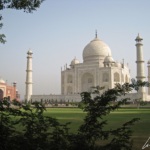














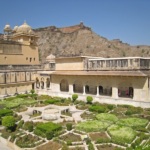

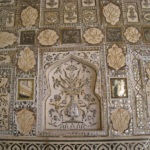
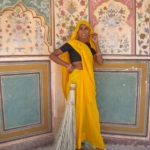
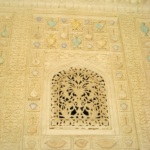


We have a friend who have always invited us to visit India and now thank to your post we know why. With your photos you inspired us and we’d love to try your same experience (the tour around India)!!
India has always been a favorite country and a visit to the Taj Majal has been one of the most fulfilling travel experience. Thanks for sharing this post. It gives me more knowledge about the great mausoleum.
Very beautiful architecture descriptions! All those places are on my top list of things to see in India, a country I hope to visit soon!